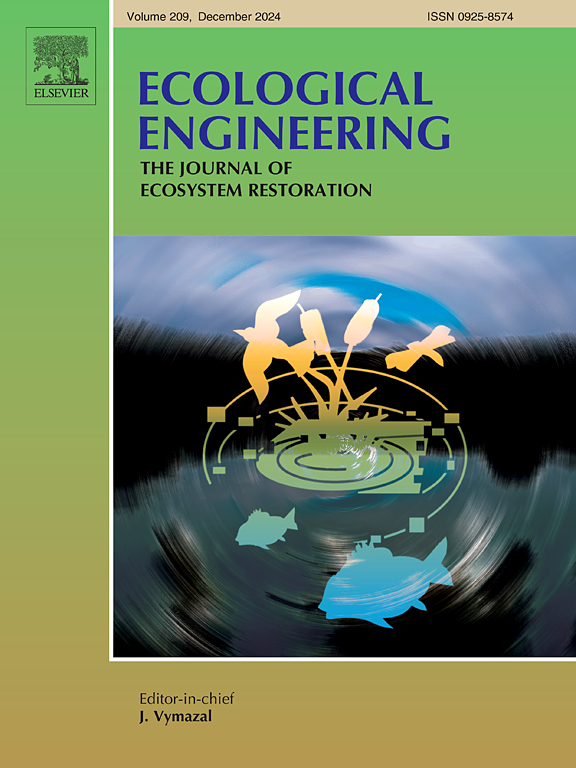中国京津冀地区人工湿地综述:水处理中的应用、问题和实际解决方案
IF 4.1
2区 环境科学与生态学
Q1 ECOLOGY
引用次数: 0
摘要
由于其环境、经济和社会优势,人工湿地(CWs)在发展中国家普遍用于污水处理。化粪池通过自然过程去除污染物,提供生态系统服务和娱乐效益。然而,由于冬季低温和废水成分的复杂性等因素,污染物去除的效率会有所不同。本文综述了中国京津冀地区化武的开发和应用情况。探讨了连续水类型与污水处理效率的关系,以及影响连续水性能的因素。结果表明,混合人工湿地对COD(43.48%)、TN(44.79%)和TP(51.50%)的去除率最高。垂直流人工湿地对NH3-N的去除率最高(71.25%)。基质选择、植物种类、水力滞留时间和污染物负荷率都会影响连续水的性能。这些污染物去除效率的变化主要归因于低溶解氧、低碳氮比和环境温度。通过间歇曝气、潮汐操作、补充电子供体底物、选择耐寒植物、增加耐寒微生物、保温材料覆盖和堵塞修复等策略可以提高污染物的去除效率。这些策略有助提高污染物去除率,并促进化粪池的可持续运作。本文章由计算机程序翻译,如有差异,请以英文原文为准。

A review on constructed wetlands in Beijing-Tianjin-Hebei region of China: Application in water treatment, problem, and practical solution
Constructed wetlands (CWs) are commonly employed in developing countries for wastewater treatment, owing to their environmental, economic, and social advantages. CWs remove pollutants through natural processes, offering ecosystem services and recreational benefits. However, the efficiency of pollutant removal varies due to factors such as low winter temperatures and the complexity of wastewater composition. This review examines the development and application of CWs in the Beijing-Tianjin-Hebei region of China. The relationship between CW type and wastewater treatment efficiency is explored, along with factors influencing CW performance. Based on monitoring data from 27 field-scale CWs, Hybrid Constructed Wetlands demonstrated the highest removal rates for COD (43.48 %), TN (44.79 %), and TP (51.50 %). Vertical Flow Constructed Wetlands achieved the highest NH3-N removal rate (71.25 %). Substrate selection, plant species, hydraulic retention time, and pollutant loading rates all influence CW performance. These variations in pollutant removal efficiency are primarily attributed to low dissolved oxygen, low C/N ratios, and ambient temperature. Pollutant removal efficiency can be enhanced through strategies such as intermittent aeration, tidal flow operation, supplementation with electron donor substrates, selection of cold-tolerant plants, augmentation of cold-tolerant microbes, insulation material cover, and clogging remediation. These strategies help increase pollutant removal rates and promote the sustainable operation of CWs.
求助全文
通过发布文献求助,成功后即可免费获取论文全文。
去求助
来源期刊

Ecological Engineering
环境科学-工程:环境
CiteScore
8.00
自引率
5.30%
发文量
293
审稿时长
57 days
期刊介绍:
Ecological engineering has been defined as the design of ecosystems for the mutual benefit of humans and nature. The journal is meant for ecologists who, because of their research interests or occupation, are involved in designing, monitoring, or restoring ecosystems, and can serve as a bridge between ecologists and engineers.
Specific topics covered in the journal include: habitat reconstruction; ecotechnology; synthetic ecology; bioengineering; restoration ecology; ecology conservation; ecosystem rehabilitation; stream and river restoration; reclamation ecology; non-renewable resource conservation. Descriptions of specific applications of ecological engineering are acceptable only when situated within context of adding novelty to current research and emphasizing ecosystem restoration. We do not accept purely descriptive reports on ecosystem structures (such as vegetation surveys), purely physical assessment of materials that can be used for ecological restoration, small-model studies carried out in the laboratory or greenhouse with artificial (waste)water or crop studies, or case studies on conventional wastewater treatment and eutrophication that do not offer an ecosystem restoration approach within the paper.
 求助内容:
求助内容: 应助结果提醒方式:
应助结果提醒方式:


